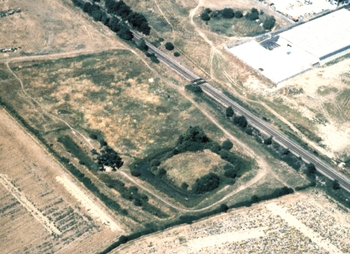Boys Hall Balancing Pond, Sevington, Kent - Post Excavation Assessment Report
Oxford Archaeology (South), 2009. (updated 2017) https://doi.org/10.5284/1044820. How to cite using this DOI
Data copyright © High Speed 1 unless otherwise stated
This work is licensed under the ADS Terms of Use and Access.
Primary contact
Stuart
Foreman
Senior Project Manager
Oxford Archaeology (South)
Janus House
Osney Mead
Oxford
OX2 0ES
UK
Tel: 01865 263800
Fax: 01865 793496
Resource identifiers
- ADS Collection: 2466
- DOI:https://doi.org/10.5284/1044820
- How to cite using this DOI
Introduction

As part of an extensive programme of archaeological investigation carried out in advance of the construction of the Channel Tunnel Rail Link (CTRL), the Oxford Archaeological Unit were commissioned by Union Railways (South) Limited to undertake a strip, map and sample excavation at Boys Hall Balancing Pond, Sevington, in Kent. The site lay immediately adjacent to Boys Hall Moat, the site of the moated manor of Sevington, which is a Scheduled Ancient Monument (Kent SAM 146). A single sherd of late Bronze Age pottery is the only evidence to suggest that the earliest features on the site may be a group of ditches which perhaps formed a field system. The majority of the features excavated date from the late Iron Age and Roman period. A series of closely spaced parallel ditches, again perhaps part of a field system, as well as the earliest of a small cluster of cremations in pits, can be dated to the earlier part of this period (late Iron Age - c AD 70). One of the ditches in this group, and three further cremations can be dated to the later part (c AD 70-200). A further cremation in the same cluster contained no pottery but probably dates from the same general phase. Two large ditches and a small cobbled area are post-medieval in date, and are probably related to the formal gardens which were laid out around Boys Hall Moat in that period.
The site is of interest in terms of the organisation of the landscape and burial practices. The burial group is of interest as small cemeteries associated with small-scale rural settlements of this period are not well known in the south-east of England (Drewett, Rudling and Gardiner 1988, 233). Unfortunately only small parts of the field systems were exposed within the area of the excavation and their wider layout is unknown. A clearer picture of their wider layout may be obtained if they can be related to features found in the numerous other investigations which have taken place around the site. It is also unfortunate that the location of any associated settlement is unknown. The site nonetheless provides some evidence for the division and organisation of the landscape. The possible middle Bronze Age ditch is of particular interest because, if it is of this date, it is amongst the earliest examples of field systems known. Its date, however, based upon only a single sherd, cannot be considered reliable.
The cremations are badly truncated and are therefore have little potential for investigating the detail of burial practices. Nevertheless the CTRL project has uncovered a number of isolated burials and cemeteries of similar date, direct comparison of which may provide some evidence for variation in burial practices in the region. They also provide evidence for the ritual organisation of the landscape, although it is again unfortunate in this respect that the wider form of the field system with which they are associated and the location of any settlement is unclear.
The fieldwork events incorporated in this report are:
- Boys Hall Balancing Pond (ARC BHB99) - Excavation






